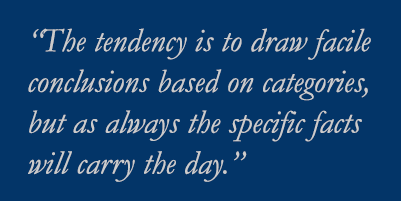Back to law school. Final exam. Torts. The year is 1909. Professor Smith sets out for your consideration the following exam question:
Father, with his sleeping child in his arms, negligently lies down in the street and goes to sleep. The driver of a wagon sees them there asleep. He intends to avoid them, but does not use due care in turning out; and hence his wheel goes over them, breaking the arms of the father and the legs of the child. Is the driver liable to anyone; and, if so, to whom and for what? Give reasons for answer.[1]
Your typical law student exam answer would have discussed any number of legal issues at length. But before reaching any of these, the first distinction to be drawn would have been between the rights of the father and the rights of the child. The father’s comparative negligence in sleeping in the street cannot be attributed to the child.
What’s the reason for this?
First, we recognize the child had no power or decision making authority. Any lack of judgment or foresight by the father in choosing the street as a place to sleep was not within the control of the child. The child was entirely powerless, and thus blameless.
Second, we cannot expect the child to have appreciated the risk. The child was oblivious to the potential harm about to be encountered. There was no way for a sleeping child to have recognized the harm or to have taken steps to have lessened the potential for injury. The child could not have acted “reasonably” since the child was entirely without the capacity to have perceived a potential future danger.
Third, we understand the child’s predicament of being placed in the street was entirely the consequence of actions taken by another. It was not the child who decided to sleep in the street, but the father. The child was entirely under the control of another. Ascribing a degree of culpability to the child under these circumstances would place a legal obligation to exercise due care on the part of someone without the means to even begin to effectuate such an obligation.
Powerlessness, incapacity, lack of control––these all bear on one issue: the ability to take reasonable steps, and make reasonable judgments, to prevent future harm from occurring. There’s no question the child’s case proceeds on its merits. The child sues both the driver and the driver’s employer and recovers full damages, not limited or reduced in the slightest by any comparative negligence that may be thought to exist on the part of the father.
But notice how adults can be placed in circumstances that are not initially thought to be hazardous only to realize later the danger they have unwittingly placed themselves in. Our first thought would be to ascribe obvious blame to the father. Everyone should know it’s not safe to sleep in the street. The exam question assumes this as well––“negligently lies down in the street…” But the question is not so easily decided. What if the father was familiar with this area and knew that at night there was no traffic? What if he placed himself and his child near the farthest curb? What if he knew the only way a wagon wheel could ever reach his location would be if the driver drove erratically, off course? If the father correctly assessed all of these beforehand, his decision, though naïve and lacking foresight, would not necessarily be per se negligent.
Powerlessness, incapacity, lack of control––to some extent we all, children and adults alike, are subject to these in varying degrees. Thus, it can be argued the father’s case proceeds on its merits as well. The father sues both the driver and the driver’s employer and recovers full damages, but the jury in assessing damages may consider the degree of his comparative fault once they are informed of the complete facts and the steps the father took to avoid harming himself and his child.
Illinois law recognizes this as well: “Sec. 11-1003.1. Drivers to exercise due care. Notwithstanding other provisions of this Code or the provisions of any local ordinance, every driver of a vehicle shall exercise due care to avoid colliding with any pedestrian, or any person operating a bicycle or other device propelled by human power and shall give warning by sounding the horn when necessary and shall exercise proper precaution upon observing any child or any obviously confused, incapacitated or intoxicated person.” (625 ILCS 5/11-1003.1)(Source: P.A. 82-132.)
One more point. “The driver of a wagon sees them there asleep”––the question imputes knowledge on the part of the driver, and thus a responsibility to take urgent measures to avoid harm. A reasonable driver would have stopped. There was no reason not to, and stopping would have avoided entirely any possibility––however slight––of an accidental rollover. If the question is phrased ––“Who had the last best chance to have avoided the accident?”––the driver can be held accountable in this manner as well (particularly when he knew of the presence of the child, someone who could move and shift position unexpectedly).
This little exam question actually raises quite a great deal about risk and responsibility, and under what circumstances liability should accrue. The tendency is to draw facile conclusions based on categories, but as always the specific facts will carry the day.
[1] Annual Examinations in Law, Harvard University, Torts, Professor Smith, Pg. 13 (1908-1909)
https://iiif.lib.harvard.edu/manifests/view/drs:17969817$1i




